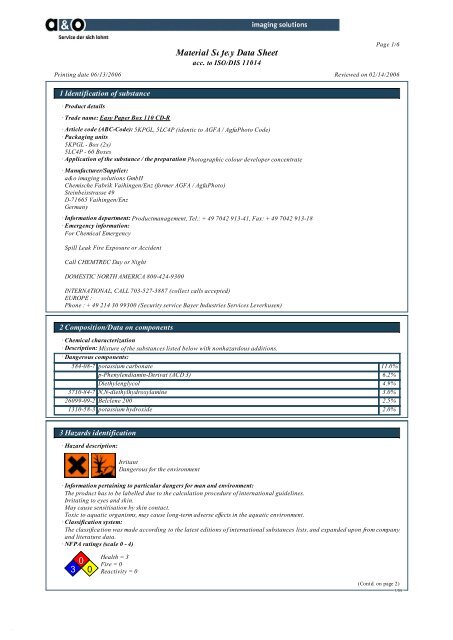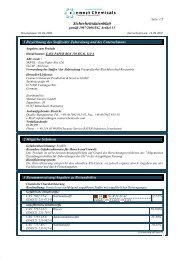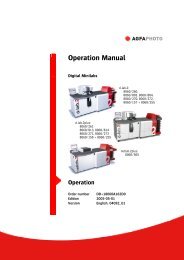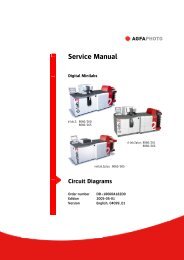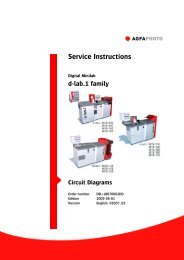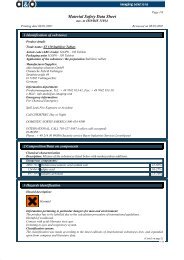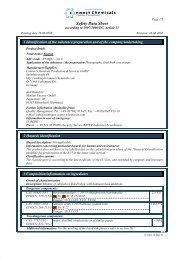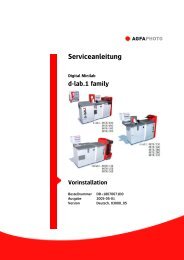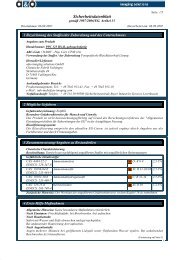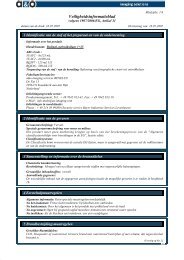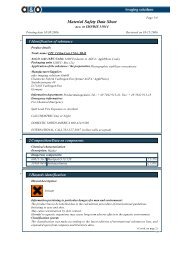US 5KPGL Easy Paper Box 110 CD-R GDLQ (USA) - D-Lab 1
US 5KPGL Easy Paper Box 110 CD-R GDLQ (USA) - D-Lab 1
US 5KPGL Easy Paper Box 110 CD-R GDLQ (USA) - D-Lab 1
- No tags were found...
You also want an ePaper? Increase the reach of your titles
YUMPU automatically turns print PDFs into web optimized ePapers that Google loves.
DRMaterial Safety Data Sheetacc. to ISO/DIS <strong>110</strong>14Page 1/6Printing date 06/13/2006 Reviewed on 02/14/20061 Identification of substance· Product details· Trade name: <strong>Easy</strong> <strong>Paper</strong> <strong>Box</strong> <strong>110</strong> <strong>CD</strong>-R· Article code (ABC-Code): <strong>5KPGL</strong>, 5LC4P (identic to AGFA / AgfaPhoto Code)· Packaging units<strong>5KPGL</strong> - <strong>Box</strong> (2x)5LC4P - 60 <strong>Box</strong>es· Application of the substance / the preparation Photographic colour developer concentrate· Manufacturer/Supplier:a&o imaging solutions GmbHChemische Fabrik Vaihingen/Enz (former AGFA / AgfaPhoto)Steinbeisstrasse 49D-71665 Vaihingen/EnzGermany· Information department: Productmanagement, Tel.: + 49 7042 913-41, Fax: + 49 7042 913-18· Emergency information:For Chemical EmergencySpill Leak Fire Exposure or AccidentCall CHEMTREC Day or NightDOMESTIC NORTH AMERICA 800-424-9300INTERNATIONAL, CALL 703-527-3887 (collect calls accepted)EUROPE :Phone : + 49 214 30 99300 (Security service Bayer Industries Services Leverkusen)2 Composition/Data on components· Chemical characterization· Description: Mixture of the substances listed below with nonhazardous additions.· Dangerous components:584-08-7 potassium carbonate 11.0%p-Phenylendiamin-Derivat (A<strong>CD</strong> 3) 6.2%Diethylenglycol 4.9%3710-84-7 N,N-diethylhydroxylamine 3.0%26099-09-2 Belclene 200 2.5%1310-58-3 potassium hydroxide 2.0%3 Hazards identification· Hazard description:IrritantDangerous for the environment· Information pertaining to particular dangers for man and environment:The product has to be labelled due to the calculation procedure of international guidelines.Irritating to eyes and skin.May cause sensitisation by skin contact.Toxic to aquatic organisms, may cause long-term adverse effects in the aquatic environment.· Classification system:The classification was made according to the latest editions of international substances lists, and expanded upon from companyand literature data.· NFPA ratings (scale 0 - 4)3 0 0Health = 3Fire = 0Reactivity = 0(Contd. on page 2)<strong>US</strong>A
DRMaterial Safety Data Sheetacc. to ISO/DIS <strong>110</strong>14Page 2/6Printing date 06/13/2006 Reviewed on 02/14/2006Trade name: <strong>Easy</strong> <strong>Paper</strong> <strong>Box</strong> <strong>110</strong> <strong>CD</strong>-R· HMIS-ratings (scale 0 - 4)(Contd. of page 1)HEALTH 3FIRE 0REACTIVITY 0Health = 3Fire = 0Reactivity = 04 First aid measures· After inhalation:Supply fresh air and to be sure call for a doctor.In case of unconsciousness place patient stably in side position for transportation.· After skin contact: Immediately wash with water and soap and rinse thoroughly.· After eye contact: Rinse opened eye for several minutes under running water. If symptoms persist, consult a doctor.· After swallowing: If symptoms persist consult doctor.5 Fire fighting measures· Suitable extinguishing agents:CO2, extinguishing powder or water spray. Fight larger fires with water spray or alcohol resistant foam.· Protective equipment: No special measures required.6 Accidental release measures· Person-related safety precautions: Not required.· Measures for environmental protection:Inform respective authorities in case of seepage into water course or sewage system.Dilute with plenty of water.Do not allow to enter sewers/ surface or ground water.· Measures for cleaning/collecting:Absorb with liquid-binding material (sand, diatomite, acid binders, universal binders, sawdust).7 Handling and storage· Handling:· Information for safe handling: No special measures required.· Information about protection against explosions and fires: No special measures required.· Storage:· Requirements to be met by storerooms and receptacles: No special requirements.· Information about storage in one common storage facility: Not required.· Further information about storage conditions: Keep receptacle tightly sealed.8 Exposure controls and personal protection· Additional information about design of technical systems: No further data; see item 7.· Components with limit values that require monitoring at the workplace:25322-68-3 Polyethylene glycolTLV (average molecular weight 200-600)WEEL 10 mg/m³DiethylenglycolWEEL 10 mg/m³1310-58-3 potassium hydroxideREL 2 mg/m³TLV Short-term value: C 2 mg/m³· Additional information: The lists that were valid during the creation were used as basis.· Personal protective equipment:· General protective and hygienic measures:Keep away from foodstuffs, beverages and feed.(Contd. on page 3)<strong>US</strong>A
DRMaterial Safety Data Sheetacc. to ISO/DIS <strong>110</strong>14Page 3/6Printing date 06/13/2006 Reviewed on 02/14/2006Trade name: <strong>Easy</strong> <strong>Paper</strong> <strong>Box</strong> <strong>110</strong> <strong>CD</strong>-RImmediately remove all soiled and contaminated clothing.Wash hands before breaks and at the end of work.Avoid contact with the eyes and skin.· Breathing equipment: Not required.· Protection of hands:(Contd. of page 2)Protective glovesThe glove material has to be impermeable and resistant to the product/ the substance/ the preparation.Due to missing tests no recommendation to the glove material can be given for the product/ the preparation/ the chemicalmixture.Selection of the glove material on consideration of the penetration times, rates of diffusion and the degradation· Material of glovesThe selection of the suitable gloves does not only depend on the material, but also on further marks of quality and varies frommanufacturer to manufacturer. As the product is a preparation of several substances, the resistance of the glove material can notbe calculated in advance and has therefore to be checked prior to the application.· Penetration time of glove materialThe exact break trough time has to be found out by the manufacturer of the protective gloves and has to be observed.· Eye protection:Tightly sealed goggles9 Physical and chemical properties· General InformationForm:Color:Odor:· Change in conditionMelting point/Melting range: Undetermined.Boiling point/Boiling range: 100°C (212°F)· Flash point: Not applicable.FluidAccording to product specificationCharacteristic· Auto igniting: Product is not selfigniting.· Danger of explosion: Product does not present an explosion hazard.· Vapor pressure at 20°C (68°F): 23 hPa (17 mm Hg)· Density at 20°C (68°F): 1.178 g/cm³· Solubility in / Miscibility withWater:· pH-value at 20°C (68°F): 13Fully miscible.· Viscosity:Kinematic at 20°C (68°F): 13 s (DIN 53211/4)· Solvent content:Organic solvents: 4.9 %Water: 57.6 %VOC content: 4.9 %· Solids content: 22.8 %10 Stability and reactivity· Thermal decomposition / conditions to be avoided: No decomposition if used according to specifications.· Dangerous reactions No dangerous reactions known.(Contd. on page 4)<strong>US</strong>A
DRMaterial Safety Data Sheetacc. to ISO/DIS <strong>110</strong>14Page 4/6Printing date 06/13/2006 Reviewed on 02/14/2006Trade name: <strong>Easy</strong> <strong>Paper</strong> <strong>Box</strong> <strong>110</strong> <strong>CD</strong>-R· Dangerous products of decomposition: No dangerous decomposition products known.(Contd. of page 3)11 Toxicological information· Acute toxicity:· LD/LC50 values that are relevant for classification:1310-58-3 potassium hydroxideOral LD50 273 mg/kg (rat)· Primary irritant effect:· on the skin: Irritant to skin and mucous membranes.· on the eye: Irritating effect.· Sensitization: Sensitization possible through skin contact.· Additional toxicological information:The product shows the following dangers according to internally approved calculation methods for preparations:Irritant12 Ecological information· Ecotoxical effects:· Remark: Toxic for fish· General notes:Water hazard class 3 (Self-assessment): extremely hazardous for waterDo not allow product to reach ground water, water course or sewage system, even in small quantities.Danger to drinking water if even extremely small quantities leak into the ground.Also poisonous for fish and plankton in water bodies.Toxic for aquatic organismsRinse off of bigger amounts into drains or the aquatic environment may lead to increased pH-values. A high pH-value harmsaquatic organisms. In the dilution of the use-level the pH-value is considerably reduced, so that after the use of the product theaqueous waste, emptied into drains, is only low water-dangerous.13 Disposal considerations· Product:· Recommendation: Must not be disposed of together with household garbage. Do not allow product to reach sewage system.· Uncleaned packagings:· Recommendation: Disposal must be made according to official regulations.· Recommended cleansing agent: Water, if necessary with cleansing agents.14 Transport information· DOT regulations:· Hazard class: 8· Identification number: UN1719· Packing group: II· Proper shipping name (technical name): CA<strong>US</strong>TIC ALKALI LIQUID, N.O.S. (potassium carbonate)· <strong>Lab</strong>el 8· Remarks: Dangerous goods in limited quantities of class 8,UN 1719 CA<strong>US</strong>TIC ALKALI LIQUID,N.O.S. (Potassium carbonate solution), PG III.(Contd. on page 5)<strong>US</strong>A
DRMaterial Safety Data Sheetacc. to ISO/DIS <strong>110</strong>14Page 5/6Printing date 06/13/2006 Reviewed on 02/14/2006Trade name: <strong>Easy</strong> <strong>Paper</strong> <strong>Box</strong> <strong>110</strong> <strong>CD</strong>-R· Land transport ADR/RID (cross-border):(Contd. of page 4)· ADR/RID class: 8 (C5) Corrosive substances· Danger code (Kemler): 80· UN-Number: 1719· Packaging group: III· <strong>Lab</strong>el: 8· Description of goods: 1719 CA<strong>US</strong>TIC ALKALI LIQUID, N.O.S. (potassium carbonate solution)· Maritime transport IMDG:· IMDG Class: 8· UN Number: 1719· <strong>Lab</strong>el 8· Packaging group: II· EMS Number: F-A,S-B· Marine pollutant: No· Propper shipping name: CA<strong>US</strong>TIC ALKALI LIQUID, N.O.S. (POTASSIUM HYDROXIDE)· Air transport ICAO-TI and IATA-DGR:· ICAO/IATA Class: 8· UN/ID Number: 1719· <strong>Lab</strong>el 8· Packaging group: II· Propper shipping name: CA<strong>US</strong>TIC ALKALI LIQUID, N.O.S. (POTASSIUM HYDROXIDE)15 Regulations· Sara· Section 355 (extremely hazardous substances):None of the ingredient is listed.· Section 313 (Specific toxic chemical listings):None of the ingredients is listed.· TSCA (Toxic Substances Control Act):7732-18-5 water, distilled, conductivity or of similar purity25322-68-3 Polyethylene glycol584-08-7 potassium carbonatep-Phenylendiamin-Derivat (A<strong>CD</strong> 3)Diethylenglycol3710-84-7 N,N-diethylhydroxylamine1310-58-3 potassium hydroxide· Proposition 65· Chemicals known to cause cancer:None of the ingredients is listed.· Chemicals known to cause reproductive toxicity for females:None of the ingredients is listed.· Chemicals known to cause reproductive toxicity for males:None of the ingredients is listed.· Chemicals known to cause developmental toxicity:None of the ingredients is listed.(Contd. on page 6)<strong>US</strong>A
DRMaterial Safety Data Sheetacc. to ISO/DIS <strong>110</strong>14Page 6/6Printing date 06/13/2006 Reviewed on 02/14/2006Trade name: <strong>Easy</strong> <strong>Paper</strong> <strong>Box</strong> <strong>110</strong> <strong>CD</strong>-R· Cancerogenity categories· EPA (Environmental Protection Agency)None of the ingredients is listed.· IARC (International Agency for Research on Cancer)None of the ingredients is listed.· NTP (National Toxicology Program)None of the ingredients is listed.· TLV (Threshold Limit Value established by ACGIH)None of the ingredients is listed.· NIOSH-Ca (National Institute for Occupational Safety and Health)None of the ingredients is listed.· OSHA-Ca (Occupational Safety & Health Administration)None of the ingredients is listed.· Product related hazard informations:The product has been classified and marked in accordance with directives on hazardous materials.· Hazard symbols:IrritantDangerous for the environment· Hazard-determining components of labelling:p-Phenylendiamin-Derivat (A<strong>CD</strong> 3)potassium hydroxide· Risk phrases:Irritating to eyes and skin.May cause sensitisation by skin contact.Toxic to aquatic organisms, may cause long-term adverse effects in the aquatic environment.· Safety phrases:Avoid contact with skin.In case of contact with eyes, rinse immediately with plenty of water and seek medical advice.Wear suitable gloves.This material and its container must be disposed of as hazardous waste.· National regulations:Class Share in %Wasser 57.6NK 4.9(Contd. of page 5)16 Other informationThis information is based on our present knowledge. However, this shall not constitute a guarantee for any specific productfeatures and shall not establish a legally valid contractual relationship.· Department issuing MSDS: Productmanagement department· Contact: Mr. Vollhofer, a&o imaging solutions, Tel.: + 49 7042 913-43<strong>US</strong>A


